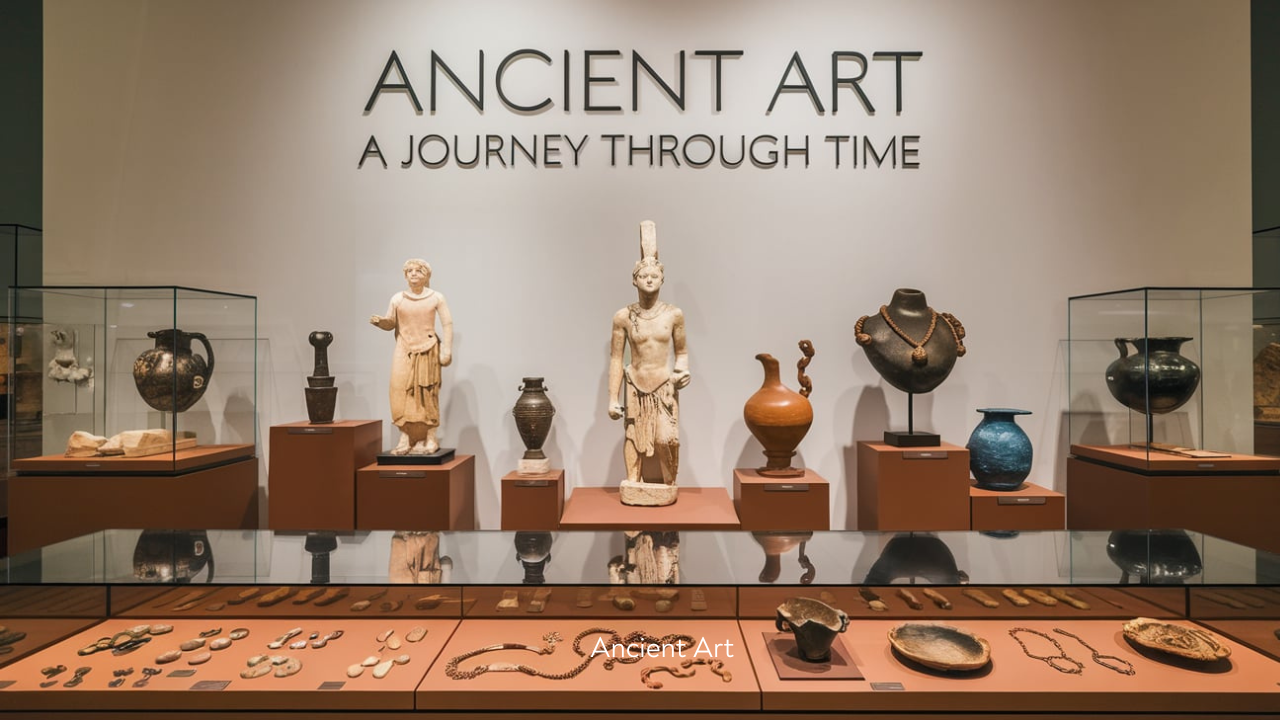Art is like a window into history, showing us how ancient civilizations lived, what they valued, and how they viewed the world. “Ancient art” refers to the various artistic traditions from early cultures around the globe. These works of art not only showcase the technical skills of early artists but also reflect their deep connections with religion, mythology, and the environment.
From the intricate carvings on the walls of Egyptian tombs to the delicate pottery of ancient Greece, ancient art spans a wide range of forms, styles, and techniques. These creations were more than just decorations; they were symbols of power, faith, and cultural identity. This article will explore the origins, influences, materials, and evolution of ancient art, providing a detailed look at how art has been a vital part of human civilization from the very beginning.
The Origins of Ancient Art: Where It All Began
The origins of ancient art are as old as humanity itself. The first expressions of art can be traced back to prehistoric times when early humans used cave walls as their canvas. These early artworks, known as cave paintings, depicted animals, human figures, and abstract symbols. They were created using simple tools and natural pigments like charcoal, ochre, and clay.
Prehistoric Art: The Dawn of Creativity
Prehistoric art marks the beginning of human creativity. The most famous examples of this art are the cave paintings found in Lascaux, France, and Altamira, Spain. These paintings, dating back over 30,000 years, were likely created for ritualistic or symbolic purposes. The images often feature animals like horses, bison, and deer, which were probably important to the survival of these communities.
The purpose of these early artworks is still debated among historians and archaeologists. Some believe they were part of religious rituals, perhaps to ensure successful hunts or honor the spirits of the animals. Others think they may have been used as a form of communication or storytelling. Whatever their purpose, these early pieces of ancient art represent humanity’s first steps in the journey of artistic expression.
The Emergence of Civilizations and Their Art
As human societies grew from small, nomadic groups to larger, settled civilizations, their art also evolved. Ancient Mesopotamia, often called the cradle of civilization, is one of the earliest examples of organized societies that produced significant artworks. The Sumerians, who lived in what is now modern-day Iraq, created some of the earliest known sculptures, pottery, and carvings. Their art was heavily influenced by their religious beliefs and often depicted gods, kings, and mythological creatures.
The Egyptians, another ancient civilization, developed a highly distinctive style of art that became iconic. Egyptian art was deeply connected to their religious beliefs and the afterlife. Temples and tombs were decorated with intricate carvings and paintings that told stories of gods, pharaohs, and the journey to the afterlife. The use of hieroglyphs, a writing system using symbolic images, is one of the most famous aspects of Egyptian art.
The Influence of Religion and Mythology on Ancient Art
Religion and mythology played a major role in shaping the art of ancient cultures. In many ancient societies, art was not just a form of expression; it was a way of communicating with the divine. The gods and goddesses of these cultures were often depicted in art, and their stories were told through detailed carvings, sculptures, and paintings.
Egyptian Religious Art: A Glimpse into the Afterlife
In ancient Egypt, religion was the driving force behind much of their art. The Egyptians believed in a complex pantheon of gods and goddesses, each with their own roles and attributes. Art was used to honor these deities and to ensure a safe passage to the afterlife. The walls of tombs were decorated with scenes of the deceased’s journey through the afterlife, guided by gods like Anubis, the god of mummification, and Osiris, the god of the afterlife.
One of the most famous examples of Egyptian religious art is the Book of the Dead, a collection of spells and prayers meant to guide the deceased through the afterlife. This text was often illustrated with detailed scenes of the journey, including the weighing of the heart, a ritual where the deceased’s heart was weighed against the feather of Ma’at, the goddess of truth and justice.
Greek Mythology and Its Influence on Art
In ancient Greece, mythology was a rich source of inspiration for artists. The stories of gods, heroes, and mythical creatures were depicted in sculptures, pottery, and frescoes. Greek artists aimed to capture the human form in all its beauty and perfection, often portraying their gods and heroes with idealized, muscular bodies.
The Parthenon, a temple dedicated to the goddess Athena, is one of the most famous examples of Greek religious art. The temple is adorned with sculptures and friezes that depict scenes from Greek mythology, including the birth of Athena and the battle between the gods and the giants. These works of art not only served a religious purpose but also celebrated the power and glory of Athens.
Greek pottery also played a significant role in depicting mythology. Vases were often decorated with scenes from myths, such as the labors of Hercules or the adventures of Odysseus. These images were not just decorative; they were used to tell stories and convey moral lessons.
The Role of Religion in Mesoamerican Art
In Mesoamerica, religion was also a major influence on art. The Mayans, Aztecs, and other cultures of the region created intricate temples, sculptures, and carvings that were dedicated to their gods. These artworks were often used in religious ceremonies and rituals, reflecting the deep spiritual beliefs of these cultures.
The Mayans, for example, built towering pyramids that were decorated with intricate carvings depicting gods, rulers, and mythological scenes. These pyramids were not just architectural feats; they were also places of worship and human sacrifice. The Mayan calendar, a complex system of timekeeping, was also a significant part of their art and was often depicted in carvings and codices.
The Aztecs, another powerful Mesoamerican civilization, also created art that was heavily influenced by their religion. They believed in a pantheon of gods who controlled every aspect of life, and their art reflected this belief. The Sun Stone, one of the most famous pieces of Aztec art, is a massive stone carving that depicts the sun god Tonatiuh and the Aztec calendar. This stone was used in religious ceremonies and is a testament to the Aztecs’ deep connection to their gods.
Materials and Techniques: Crafting Masterpieces in Ancient Art
Creating ancient art required not only creativity but also a mastery of materials and techniques. Ancient artists worked with various materials like stone, wood, metal, and clay to create intricate and lasting masterpieces.
Stone Carving: The Foundation of Monumental Art
Stone was widely used in ancient art, particularly for large-scale works like statues and temples. Carving stone required immense skill and patience, as it involved hard materials such as limestone, granite, and marble. Despite using simple tools like chisels and hammers, artists achieved precise and realistic results.
Famous examples include the Great Sphinx of Giza in Egypt, carved from a single block of limestone, symbolizing the power of the pharaohs. In ancient Greece, stone carving reached its peak with realistic sculptures of gods, athletes, and heroes, such as the statue of Zeus at Olympia.
Metalwork: Forging Art from Fire
Metalwork was a significant aspect of ancient art. Artists worked with metals like gold, silver, bronze, and iron to create jewelry, weapons, statues, and ceremonial objects. This craft required a deep understanding of metallurgy to heat, mold, and shape metals.
The ancient Egyptians excelled in metalwork, creating intricate gold jewelry and ceremonial objects. The famous gold funerary mask of Tutankhamun is a prime example of their skill. In Greece and Rome, bronze was preferred for statues, like the Riace Warriors, showcasing the artistry of ancient bronze work.
Pottery and Ceramics: Art for Everyday Life
Pottery and ceramics were prevalent forms of ancient art, used for everyday items and decorative pieces. Artists shaped clay and fired it in kilns, often decorating the finished pieces with painted designs or glazes.
In ancient Greece, pottery was essential to daily life, with distinctive black-figure and red-figure designs. Greek vases often depicted scenes from mythology, daily life, and athletic competitions. The ancient Chinese were also masters of ceramics, creating highly valued porcelain pieces, such as those traded along the Silk Road. The Terracotta Army, life-sized clay soldiers buried with China’s first emperor, is a testament to their craftsmanship.
Painting and Frescoes: Bringing Color to Life
Painting was an important art form in cultures like ancient Egypt, Greece, and Rome. Paintings decorated temples, tombs, and homes, adding color and life to these spaces. Frescoes, a type of wall painting, were particularly popular in ancient Rome.
Egyptian art, often found in tombs, depicted scenes from the deceased’s life and journey to the afterlife, using vivid colors and stylized forms. Greek painting, found on pottery and temple walls, used perspective and shading to create dynamic images. Roman frescoes, such as those in Pompeii, depicted mythology, landscapes, and daily life, preserving vibrant scenes of Roman culture.
The Evolution of Artistic Styles in Ancient Art: A Timeline
Artistic styles in ancient art evolved over time, influenced by societal changes, religion, and cultural exchanges. This evolution is seen through key periods and cultures, each contributing uniquely to art’s development.
- The Prehistoric Era: Marked by early artistic expressions like cave paintings and carvings, emphasizing survival and spirituality.
- Ancient Mesopotamia: Art was functional and religious, with ziggurats and cylinder seals reflecting their beliefs and societal structure.
- Ancient Egypt: Art was highly symbolic, focused on the afterlife and religion, with temples, tombs, and hieroglyphics defining the style.
- Classical Greece: Art celebrated humanism, beauty, and the idealized human form, with realistic sculptures and architectural feats like the Parthenon.
- Ancient Rome: Influenced by Greek art, Roman art was grand, realistic, and focused on depicting power, with innovations in architecture and engineering.
The styles and techniques developed in ancient art laid the foundation for later artistic movements and continue to inspire artists today.
Conclusion: The Lasting Legacy of Ancient Art
Ancient art offers us a glimpse into the minds and cultures of early civilizations. Through their art, ancient people communicated their beliefs, celebrated their achievements, and left behind a rich visual history that still captivates us today. From the first cave paintings to the grand temples of Egypt and Greece, ancient art is a testament to humanity’s enduring creativity and desire to connect with the world around them.
The techniques, styles, and materials developed by ancient artists have had a lasting impact on art history, influencing countless generations of artists. Even in our modern world, we continue to draw inspiration from these ancient masterpieces, finding new meaning in the works created thousands of years ago.










